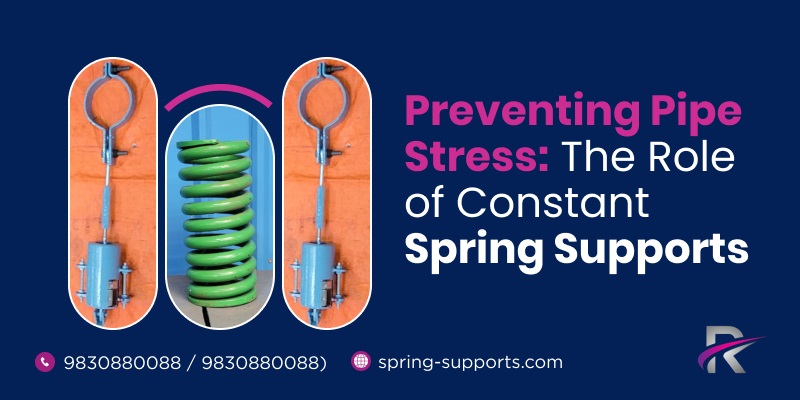Preventing Pipe Stress: Constant Spring Support Insights

Constant spring supports are an essential element in ensuring the durability of industrial piping systems. As a spring support manufacturer, we understand the importance of designing specialised supports that can absorb thermal expansion and contraction. These supports act as a countermeasure against the forces generated by temperature fluctuations, thereby stabilising and protecting pipelines from substantial strain and damage.
By preventing pipe stress and damage, constant spring supports help industrial plants avoid costly repairs and reduce the risk of catastrophic failures. In this blog, we aim to explore the functionality of constant spring supports and their critical role in maintaining the reliability and safety of industrial piping systems.
How Constant Spring Supports Prevent Pipe Stress and Damage
As a leading pipe support manufacturer, it is crucial to understand the importance of constant springs in safeguarding and supporting piping systems. These innovative supports play a vital role in reducing stress and minimising the risk of harm by absorbing and distributing the weight of the pipe. With their flexible support system, constant springs allow for thermal expansion and contraction, preventing excessive strain on the pipe and reducing the likelihood of cracks or leaks.
Key Features of Constant Spring Supports for Preventing Pipe Stress
- Constant spring supports counteract the weight of the pipe and prevent excessive stress and potential damage.
- They allow for vertical movement of the pipe to accommodate thermal expansion and contraction.
- They reduce the risk of fatigue failure resulting from repeated loading and unloading.
- These supports are adjustable, making installation and fine-tuning easy for different pipe configurations.
Proper Installation Techniques for Constant Spring Support
Before installing constant spring supports, it is crucial to accurately calculate the required support spacing based on the weight and thermal expansion of the pipeline. This calculation ensures that the supports are strategically placed along the length of the pipeline to provide optimal support and stress prevention.
Once the spacing is determined, the constant spring hangers should be securely fastened to the structure using appropriate mounting brackets or clamps. This ensures that the supports remain in place and can effectively distribute the weight of the pipe.
Alignment adjustments may be necessary during installation to ensure the proper functioning of the constant spring supports. It is important to align the supports with the direction of pipe movement to allow for optimal absorption of movement and vibrations.
In complex installations, it is recommended to consult manufacturer guidelines or seek professional assistance. This ensures that the constant spring supports are installed correctly and perform as intended, minimising the risk of stress-related issues and pipe damage.
Regular Inspection and Maintenance
Regular visual inspections should be carried out to identify any signs of misalignment, corrosion, or fatigue in the constant spring supports. These inspections are essential in ensuring that the supports are functioning properly and providing the necessary support to prevent pipe stress and damage.
Periodic load testing of the constant spring hangers can also help detect any loss in load-carrying capacity over time. By subjecting the supports to a controlled load, any weaknesses or issues can be identified and addressed before they cause major problems.
Applications of Constant Spring Supports
Constant spring supports have become a staple in various industries to provide reliable support for pipelines and prevent stress and damage.
- Industrial Applications
Constant spring supports are widely utilised in various industries, such as power plants, oil refineries, chemical plants, and other industrial facilities. These supports play a crucial role in ensuring proper support for pipelines, preventing strain or failure.
In the petrochemical industry, constant spring supports are frequently employed to provide support for process piping systems that transport fluids at high temperatures or under high pressures.
In the offshore oil and gas industry, these supports are utilized to secure subsea pipelines, effectively preventing stress-induced damage caused by wave motion or currents.
- Commercial Applications
In commercial buildings such as shopping malls or office complexes, constant spring supports are installed to support HVAC ductwork and prevent strain on the system. These supports play a key role in maintaining the stability and alignment of the ductwork, ensuring optimal airflow, and preventing potential damage. Similarly, they are commonly used in large-scale refrigeration systems found in supermarkets or food processing plants to ensure the proper alignment of pipes carrying chilled fluids.
Advantages of Constant Spring Supports
Constant spring support plays a vital role in preventing pipe stress and damage. Not only do they reduce pipe stress, but they also help maintain proper alignment, preventing misalignment issues that can lead to further stress on the pipes.
- Continuous Load Support
Constant spring supports offer reliable load support for pipes, allowing them to expand and contract without experiencing excessive stress or strain. With continuous load support provided by constant spring supports, the risk of sagging or deformation in the pipes is significantly reduced.
- Reduced Pipe Stress
One of the key benefits of constant spring supports is their ability to reduce pipe stress levels by absorbing thermal expansion and contraction. By redistributing forces exerted on the pipes due to changes in temperature or fluid flow rates, constant spring supports help minimise localised stresses.
- Increased System Lifespan
With their ability to minimise pipe stress levels and prevent damage, constant spring supports contribute to extending the overall lifespan of piping systems. By reducing wear and tear on pipes caused by excessive movement or vibration, these supports help prolong their operational life.
Conclusion:
Constant spring supports are essential components in preventing pipe stress and damage. These supports provide continuous load support, ensuring that the weight of the pipe is evenly distributed and preventing excessive stress on specific points of the pipe. By minimising wear and tear on pipes and other components, constant spring support increases the lifespan of the entire system. Therefore, investing in constant spring supports is a wise choice for any facility looking to protect its piping systems and ensure their smooth operation.


